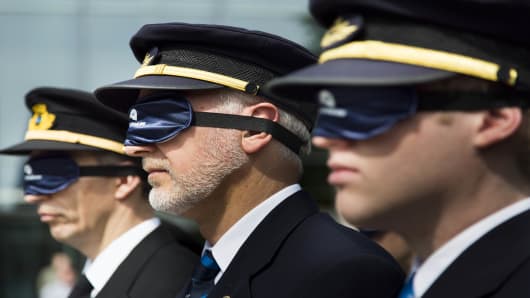There are a lot of obstacles for airlines to navigate in India as they attempt to expand operations and turn profits.
Sleeping pilots is one of the more unexpected ones.
India - revealed by the UN this year as among the 13 worst countries for air safety - had to deal with an embarrassing case of sleeping pilots this year, adding to previous shock stories of pilots with fake licenses and drunkenness in the cockpit.
In May, four employees of Air India were suspended by the aviation regulator after newspaper reports that two pilots had left the controls of a flight from Bangkok to Delhi in the hands of two air attendants while they allegedly went to sleep in business class.
Air India denied the allegations, although the company did admit the pilots had been "distracted" and the auto-pilot was disconnected.
However, unintentional naps could be a thing of the past now that India's aviation regulator, the Directorate General Civil Aviation (DGCA), drafted rules to allow a pilot to take a nap on the flight deck while another pilot took control of the aircraft during long-haul flights.
DGCA's draft rules would allow controlled rest periods for no longer than 40 minutes, followed by another 20-minute reorientation period before they can resume control of the plane. This would only be permitted on flights of over three hours and under certain conditions.
Such plans would delight pilots and their unions in India, who have long sought an alleviation to flight fatigue. The Times of India reported that some pilots had already organized non-approved rest periods during flights.
What Is Controlled Rest?
Many passengers may not know this, but controlled rests are used by pilots in different countries to combat fatigue on long-haul sectors.
And what exactly does "controlled rest" mean?
"It's sleeping," says Rob Hunter, head of flight safety for the British Airline Pilots Association (BALPA) and a former commercial airline pilot himself.
"Sleeping always tends to be talked about in terms of a euphemism, like controlled rest, because people feel much more comfortable with that language."
Indeed, in the Fatigue Risk Management System (FRMS) guidelines agreed by the International Air Transport Association (IATA), the International Civil Aviation Organization (ICAO) and the International Federation of Airline Pilots' Associations (IFALPA), controlled rest is recommended on the flight deck for a commercial aircraft, but it's not really defined.
It does state "it is not a substitute for pre-flight sleep or for normal crew augmentation, but intended as a response to unexpected fatigue experienced during operations."
It is clear, however, that it entails sleep, hence rule number 19 of the controlled rest guidelines reads: "Hand-over of duties and wake-up arrangements should be reviewed." The guidelines state that pilots may rest for no longer than 45 minutes so as to avoid the risks of sleep inertia.
For Hunter, the vagueness of what controlled rest entails is a dangerous one. "When you look at the reality, the repercussions are not fully worked through," he says. "For example, if you were resting you might be awake, but if you're sleeping you're not awake, and that has a whole set of implications if there's an emergency."
Hunter says that in an ideal world, pilots would not be tired: "The issue about sleeping on the flight deck is that pilots shouldn't be so tired that they have to do it, but if you do have to do it, then it is sensible to do it."
Hunter said pilots would not declare themselves unfit before a flight as it would look bad on their record with the company.
That is difficult for many pilots who work on, for example, the trans-Atlantic routes and arrive for duty in the early hours of the morning.
Matters are not made easier by the proposed new European Flight Time Limitations currently being debated by the European Commission which, according to Hunter, would cause pilots to have seven early starts in a row and result in pilots landing aircraft having been awake for 22 hours.
With the guidelines from the FRMS and the proposed rules from India, one question still remains unanswered for Hunter: does anyone monitor the co-pilot who takes charge of the resting pilot?
"We need to understand what the risks are of the other pilot falling asleep," he says, "and that pilot needs to be more closely monitored."


